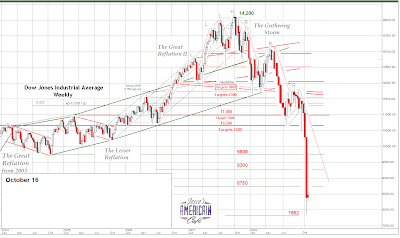Oh yes. This will surely work.
Keeping the insolvent Morgan Stanley and Goldman Sachs on life support, and paralyzing an entire economy and its banking system to cover their embarrassment.
Reuters
Banks borrow record $437.5 billion per day from Fed
Thu Oct 16, 2008 5:14pm EDT
NEW YORK (Reuters) - Financial institutions ran to their lender of last resort for record amounts of cash in the latest week, under extreme pressure from the worst global financial crisis in a generation, Federal Reserve data showed on Thursday.
Banks and dealers' overall direct borrowings from the Fed averaged a record $437.53 billion per day in the week ended October 15, topping the previous week's $420.16 billion per day.
Some analysts are concerned that banks' dependence on Fed lending might become long term and difficult to change.
"The banking system is going to become addicted to this very cheap money. Unwinding it will be very difficult," said Howard Simons, strategist with Bianco Research in Chicago.
"We have effectively allowed the central banks to disintermediate the banking system. Why would I want to borrow from you if I could do it with the central bank, because they can always print it up and say 'here'...and they are in the business now of making sure I stay in business," Simons said.
Primary credit discount window borrowings averaged a record $99.66 billion per day in the latest week, up from $75.0 billion per day the previous week.
Primary dealer and other broker dealer borrowings were $133.87 billion as of October 15, versus $122.94 billion on October 8.
"Other credit extensions", mostly reflecting loans to insurer AIG, were $82.86 billion as of October 15, versus $70.30 billion as of October 8.
The Fed's lending to banks to enable them to purchase asset-backed commercial paper from money market mutual funds was $122.76 billion as of October 15, versus $139.48 billion on October 8.
Proceeds from the U.S. Treasury's sales of Treasury bills in the Fed's supplementary financing account, which are helping to fund the Fed's support of financial institutions, were $499.13 billion as of October 15, versus $459.25 billion as of October 8.






































